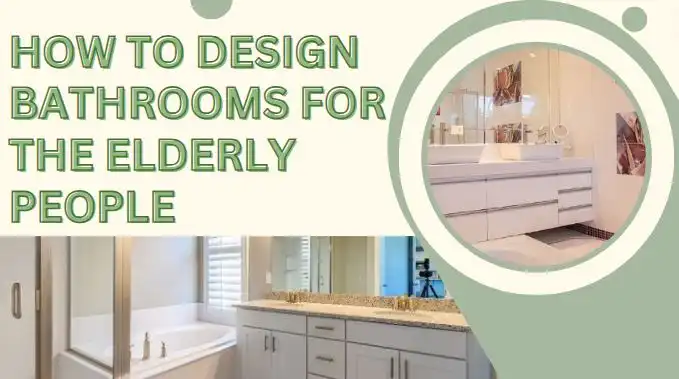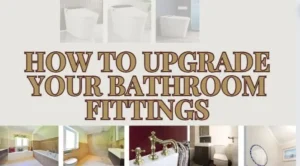When designing bathrooms for elderly, safety and comfort are top priorities. As we age, our mobility and physical strength often decrease, making everyday tasks more challenging. A well-designed bathroom can help reduce the risk of accidents and provide independence for seniors.
Easy Access for Bathrooms for Elderly

Creating a bathroom that is easily accessible for the elderly is all about making sure they can use it safely and comfortably without needing help. Here’s how to do it:
Walk-In Tubs and Showers: These are like doors that open into the bath or shower, so there’s no need to climb over a high side. This makes it much safer because it reduces the risk of falling.
Grab Bars: These are sturdy handles installed on the walls near the toilet, shower, and bathtub. Grab bars give something to hold onto, which helps with balance and prevents slips.

Shower Seats: A seat in the shower means an elderly person can sit down while showering, which is safer and more comfortable than standing the whole time.
Adjustable Shower Heads: These can move up and down or come off the wall so that someone can use them while sitting down.
Non-Slip Mats: These go on the floor of the shower or tub and outside of it too. They have a rough surface that helps prevent feet from slipping.

Raised Toilet Seats: These are toilets that are a bit higher than normal ones, which makes it easier to sit down and stand up without straining knees or backs.
Lever Faucets: These are taps that you can push up or down with your elbow or wrist, which is easier than turning knobs, especially if your hands are weak or sore.
Good Lighting: Bright lights help people see where they’re going, which is really important to avoid trips and falls.
Wide Doorways: If the bathroom door is wide, it’s easier to get in and out, especially if someone uses a walker or wheelchair.
Flooring: The floor should be smooth enough to move easily on but not so slick that it’s easy to slip. It’s like finding the perfect balance.
By including these features, we make sure that the bathroom is a safe place for the elderly, giving them the independence they need and deserve. It’s all about removing obstacles and making everything within easy reach.
Comfortable Use for Bathrooms for Elderly

When we talk about making a bathroom comfortable for the elderly, we’re focusing on how to make it easier for them to use. Here’s what that involves:
Raised Toilets: These are toilets that are a bit taller than usual. This helps because it means less bending to sit down or stand up, which can be hard for some seniors.
Handheld Showerheads: These are showerheads you can hold in your hand. They’re great because you can move the water right where you want it, and you don’t have to twist or turn to rinse off.
Easy-to-Turn Faucets: Faucets should be easy to turn on and off, even if hands are weak. Lever-style handles work well because you can use your whole hand or even an arm to move them.
Seating in the Shower: A sturdy seat in the shower means you can sit down while washing. It’s safer and can help if you get tired standing too long.
Adjustable Mirrors: Mirrors that can tilt or move up and down are helpful. They let you see yourself easily, whether you’re standing or sitting.
Good Lighting: Bright, clear lights make it easier to see what you’re doing, which helps avoid mistakes like mixing up shampoo and conditioner.
Non-Slip Surfaces: Floors and seats that are non-slip mean there’s less chance of falling, which is a big concern in bathrooms.
Temperature Control: Being able to easily adjust the water temperature is important to prevent burns and make sure the bath or shower feels comfortable.
By thinking about these things, we can make a bathroom that’s not just safe, but also a nice place for elderly people to use. It’s all about making sure they can do what they need to without struggling or feeling uncomfortable.
Slip Prevention for Bathrooms for Elderly

Slip prevention is super important in bathrooms for the elderly because falls can be really dangerous. Here’s how to make a bathroom safer:
Non-Slip Mats: These are mats with a grippy surface that you put on the floor of the shower or tub. They stick to the bottom so they don’t move around, and they help feet stay put without sliding.
Bath Mats: Outside the shower or tub, you should have bath mats that soak up water. They should have a rubber backing so they don’t slip on the floor.
Grab Bars: These are strong bars fixed to the walls near the shower, tub, and toilet. They’re there to grab onto if someone feels like they’re losing their balance.
Non-Slip Flooring: The whole bathroom floor should be made of non-slip material. This means that even if water spills, it’s less likely someone will fall.
Shower Seats: Having a seat in the shower means an elderly person can sit down while showering, which is much safer than standing.
Handheld Showerheads: These let you control where the water goes without moving around too much, which can help prevent slips.
Curbless Showers: Showers without a step to get in are great because there’s nothing to trip over.
Bright Lighting: Good lighting helps people see any wet spots on the floor so they can avoid them.
By putting these things in a bathroom, we can help make sure that elderly people don’t slip and fall, which keeps them safer and more confident when they’re using the bathroom.
Visibility in Bathrooms for Elderly
Making sure that everything in the bathroom is easy to see is really important for elderly people. Here’s how to do it:
Bright Lights: Good lighting is key. It should be bright enough to light up the whole room without creating glare, which can be blinding.
Color Contrast: Use colors that stand out against each other. For example, if the toilet seat is white, the floor should be a darker color. This helps people see things clearly and avoid accidents.
Night Lights: Having small lights that stay on all night can help when it’s dark. They make it safer to walk to the bathroom at night.
Clear Paths: Keep the floor free of clutter. There should be nothing that someone could trip over.
Labels: Put labels on things like hot and cold faucets. The writing should be big and clear.
Magnifying Glass: Having a magnifying glass handy can help read small labels on medicine or toiletries.
Shower Door: If there’s a glass door, it should have stickers or decals at eye level so it’s easy to see.
By focusing on these visibility features, we can help prevent accidents and make the bathroom a safer place for the elderly. It’s all about making sure they can see everything they need to use without any trouble.
Storage and Accessibility in Bathrooms for Elderly

When we talk about storage and accessibility in bathrooms for the elderly, we’re focusing on making sure everything they need is easy to reach and use. Here’s how to make that happen:
Lowered Shelves and Cabinets: These are storage spaces that are placed lower so they can be reached without having to stretch or stand on tiptoes.
Pull-Out Shelves: Shelves that slide out mean you don’t have to dig around in the back of a cabinet to find what you need.
Easy-Open Handles: Doors and drawers should have handles that are easy to grab and pull, even if someone’s hands aren’t very strong.
Seating: Having a place to sit down in the bathroom is helpful, not just in the shower but also in front of the mirror or sink.
Non-Slip Surfaces: Just like in other parts of the bathroom, anything that might get wet should have a non-slip surface.
Good Lighting: It’s important to have bright lights everywhere, so it’s easy to see inside cabinets and drawers.
Accessible Outlets: Electrical outlets should be at a height that’s easy to reach, so there’s no need to bend down too far.
Clear Labels: Labels on shelves and drawers can help keep things organized and make it easier to find what you’re looking for.
By thinking about these features, we can make a bathroom that’s not just safe but also really user-friendly for elderly people. It’s all about making sure they can get to their stuff easily and safely.
Temperature Control

Thermostatic Controls: Install thermostatic mixing valves to maintain a safe water temperature and prevent scalding.
Heated Floors: Underfloor heating can keep the bathroom warm, which is especially beneficial for seniors who are sensitive to cold.
Emergency Assistance
Emergency Call Button: An emergency button within reach can be a lifesaver. It should be placed near the toilet and shower.
Voice-Controlled Technology: Smart home devices can allow seniors to control lights, call for help, or operate fixtures with voice commands.
Maintenance and Cleaning
Easy-to-Clean Surfaces: Choose materials that are easy to clean and require less maintenance to reduce the effort needed for upkeep.
Antimicrobial Fixtures: Fixtures with antimicrobial coatings can help keep the bathroom sanitary without constant cleaning.
Personalization
Adjustable Features: Consider installing adjustable showerheads, mirror heights, and shelving to accommodate different needs and preferences.
Personal Touches: Allow space for personal items and decorations to make the bathroom feel more comfortable and homey.
Conclusion
Creating a safe and comfortable bathroom for elderly doesn’t have to be complicated. By focusing on easy access, comfort, slip prevention, visibility, and accessibility, we can design a space that supports seniors in their daily routines.
By considering temperature control, emergency assistance, ease of maintenance, and personalization, we create a functional and secure environment that caters to the unique needs of seniors. Remember, the goal is to promote independence and safety for our loved ones as they age.
Disclosure: This content is reader-supported, as an Amazon Associate, we earn from qualifying purchases. Support us!



